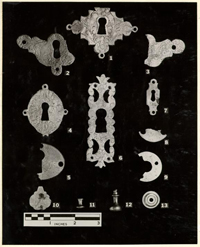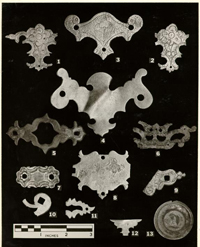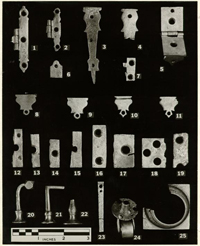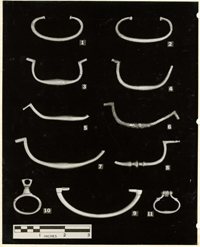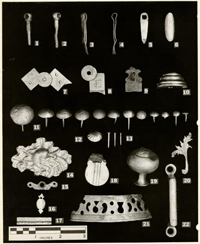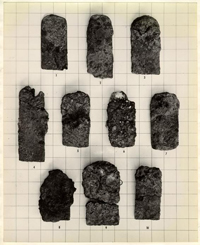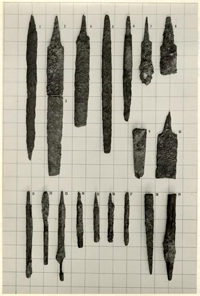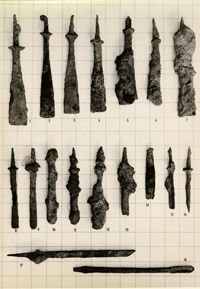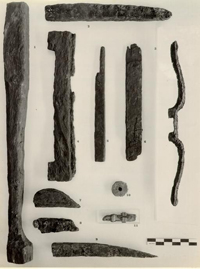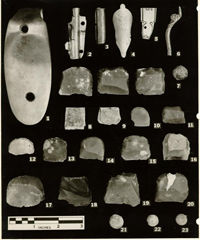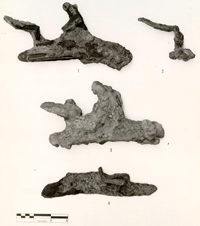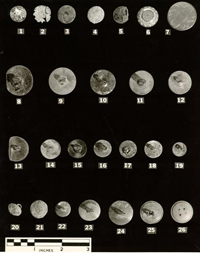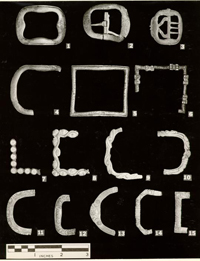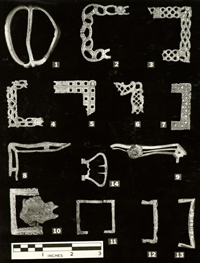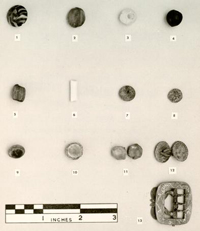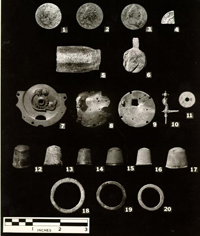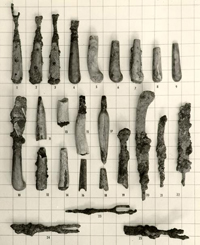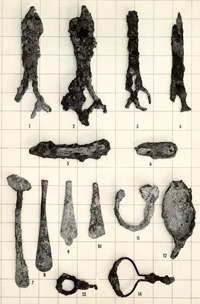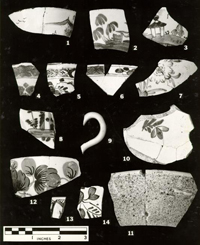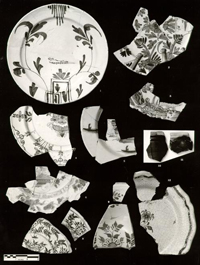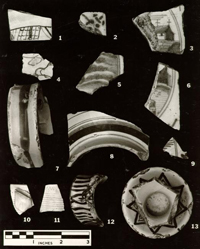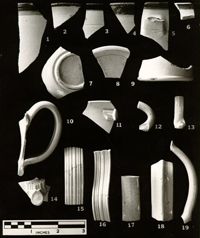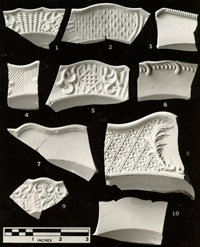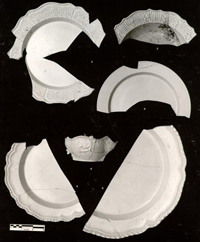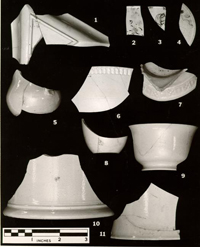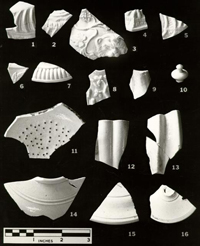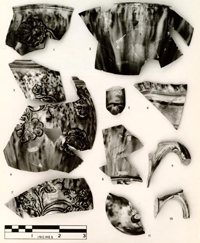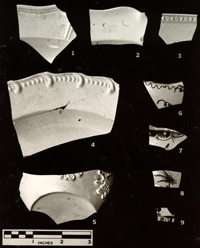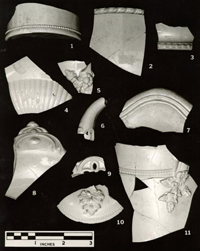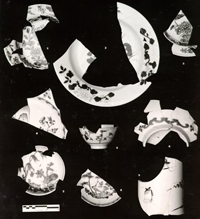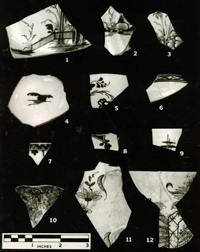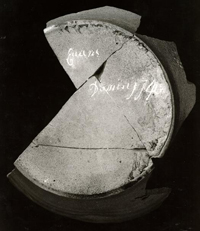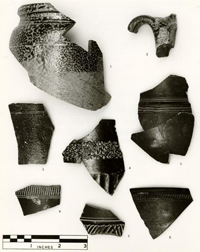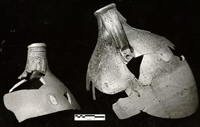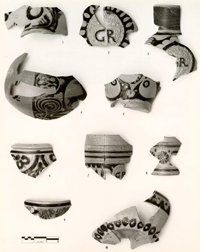Anthony Hay House (NB) Archaeological Report
Vol. III Part I, Block 28 Building 71 Lot 263-264Originally entitled: "The Anthony Hay Site Block 28,
Area D, Colonial Lots 263 and 264 Volume III Part I"
Colonial Williamsburg Foundation Library Research Report Series - 1554
Colonial Williamsburg Foundation Library
Williamsburg, Virginia
1990
THE ANTHONY HAY SITE
Block 28, Area D
Colonial Lots 263 and 264REPORT ON ARCHAEOLOGICAL EXCAVATIONS OF 1959-1960
THE ARTIFACTS
Volume III
Part I
- Part 1
-
- Table of figures
- Bibliographic abbreviations
- Introduction
- Figures 1 to 35
- Part 2
-
- Figures 36 to 64
- Dating of Excavation Register Groups
- List of photograph negative numbers
TABLE OF CONTENTS
| Figure 1. | Cabinet hardware |
| 2 | Cabinet hardware |
| 3 | Cabinet hardware |
| 4 | Cabinet hardware |
| 5 | Cabinet hardware |
| 6 | Plane irons |
| 7 | Files, rasps, punches |
| 8 | Chisels and other tools |
| 9 | Wooden objects |
| 10 | Military items |
| 11 | Gun locks |
| 12 | Buttons |
| 13 | Buckles |
| 14 | Buckles |
| 15 | Beads, "gems", sleeve buttons and knee buckle |
| 16 | Coins, thimbles, curtain rings, watch parts and other small finds |
| 17 | Cutlery |
| 18 | Spoons, scissors, clasp knives and corkscrews |
| 19 | Delftware |
| 19a | Delftware |
| 20 | Delftware |
| 21 | Dipped and white saltglaze |
| 22 | White saltglaze |
| 23 | White saltglaze |
| 24 | Plain and enamelled white saltglaze |
| 25 | White saltglaze |
| 26 | Whieldon-Wedgwood wares |
| 27 | Plain and painted creamware |
| 28 | Creamware |
| 29 | Chinese export and English porcelain |
| 30 | English porcelain |
| 31 | Inscribed base of brown stoneware vessel, 1740 |
| 32 | Yorktown and Nottingham stonewares |
| 33 | German and English brown stoneware bottles |
| 34 | German stonewares |
| 35 | Chamberpots and closestool pan |
| 36 | West of England earthenware bowl |
| 37 | Slipwares |
| 38 | Slipwares |
| 39 | Slipwares and other earthenwares |
| 40 | Colono-Indian pottery and lithic point |
| 41 | Opaque white glass tankard |
| 42 | Wine glasses and mallet decanter base |
| 43 | Wine glass stems and other fragments |
| 44 | Wine glass stems |
| 45 | Tumbler bases, handles and other fragments |
| 46 | Pharmaceutical bottles and other fragments |
| 47 | Stoppers and other glass fragments |
| 48 | Wine bottle seals |
| 49 | Wine and other glass bottles |
| 50 | Bottle and jar fragments |
| 51 | Bottles, various |
| 52 | Mirror plate, crown and other glass fragments |
| 53 | Objects of lead and brass |
| 54 | Small finds, various |
| 55 | Copper and brass kettle parts and spiggot |
| 55a | Orthopaedic corset |
| 56 | Iron locks and other items from the Hay residence |
| 57 | Builders' hardware |
| 58 | Builders' hardware |
| 59 | Domestic hardware |
| 60 | Cannon balls and other iron objects |
| 61 | Brass horse furniture |
| 62 | Iron horse furniture |
| 63 | Iron horse furniture |
| 64 | Agricultural items |
Bibliographic Abbreviations
- Burnap The Frank P. and Harriet C. Burnap Collection of English Pottery, Nelson-Atkins Gallery of Art, Kansas City, 1953.
- Calver & Bolton William Louis Calver and Reginald Pelham Bolton, History Written With Pick and Shovel, New York Historical Society, 1950.
- English Ceramic Circle Catalogue English Pottery and Porcelain, Catalogue of an English Ceramic Circle Exhibition at the Victoria and Albert Museum, London, 1948.
- Garner F. H. Garner, English Delftware, London, 1950.
- Haynes E. Barrington Haynes, Glass Through the Ages, Middlesex, 1948.
- Hughes G. Bernard Hughes, English, Scottish and Irish Table Glass, London, 1956.
- Jewitt Llewellyn Jewitt, The Ceramic Art of Great Britain, London, 1878.
- McKearin George S. and Helen McKearin, American Glass, New York, 1959.
- Mercer Henry C. Mercer, Ancient Carpenters' Tools, Doylestown, Pennsylvania, 1951.
- Michaelis Ronald F. Michaelis, Antique Pewter of the British Isles, London, 1955.
- Newman Eric P. Newman, Coinage for Colonial Virginia, American Numismatic Society, New York, 1956.
- Nutting Wallace Nutting, Furniture Treasury, New York, 1954.
- Peterson Harold L. Peterson, Arms and Armor in Colonial America, Harrisburg, Pennsylvania, 1956.
- Towner Donald C. Towner, English Cream-coloured Earthenware, London.
- Tutter's Neck I. Noël Hume, Excavations at Tutter's Neck, James City County in Virginia, 1960-1961, Smithsonian Ms. Report, 1961.
Introduction
The following captioned photographs represent a selection of the artifacts from the 1959-1960 Anthony Hay site excavations and are intended to illustrate examples in all the basic categories.
Size is indicated either by a graphic scale or by the use of a one-inch squared background.
Excavation Register (E.R.) numbers at the end of each caption indicate the different strata and deposits from which the pieces were obtained. A table of dating for these numbers will be found at the rear of the figures.
This volume is not a complete record of all the artifacts from the site, nor does the caption material claim to include all that can or should be said of each item. It is hoped that when time permits, a full and careful study of the entire artifact collection will be undertaken and a complete report made.
Figure 1
- 1Keyhole escutcheon, brass, beveled edges, stamped foliate ornament; a form frequently associated with cupboards of the period c.1690-1710. (Nutting, 470 471). E.R.231C.
- 2Keyhole escutcheon, brass, beveled edges, stamped ornament. A Queen Anne form. (Nutting, 3690). E.R.195.
- 3As above, fragmentary. E.R.230D.
- 4Keyhole escutcheon, oval, brass, stamped foliate ornament. Queen Anne form. (Country Life, March 10, 1960, recent sale-room items. Fig. 2). A type usually associated with cupboards and bookcases. E.R.205.
- 5Keyhole escutcheon, brass, oval, beveled edges, incomplete. E.R.243.
- 6Keyhole escutcheon, brass, cutout ornament, stamped decoration; bookcase or tall case clock form, first quarter of 18th century. E.R.230E.
- 7Keyhole escutcheon, brass, beveled edges, probably from clock or bookcase. E.R.337.
- 8Washer fragment, brass, possibly from door knob. E.R.222A.
- 9Washer fragment, brass, probably from door knob. (See Fig. 5, No. 19). E.R.258.
- 10Book clasp, brass, stamped tulip decoration, attached to cover by two small iron nails. E.R.191.
- 11Pull, brass, with hole in shank for nail; probably from secretary drawer. (Nutting, 687, 3697-3725). E.R.256A.
- 12Pull, brass, screw terminal broken; probably from secretary slider. (Nutting, 687, 3697-3725).
- 13Disc, brass, ornamented with raised concentric rings; perhaps washer for a pull, or tear-drop handle (Nutting, 3741), E.R.256A.
Figure 2
- 1Handle escutcheon, stamped brass, crude floral ornament of common style. This type of plate was common in the period c.1690-1730. (Nutting, 3623, 3735) E.R.247B.
- 2As No. 1. E.R.247C.
- 3Handle escutcheon, brass, with stamped and chased ornament; note roughly beveled edges. Probably second quarter of 18th century. E.R.230E.
- 4Handle escutcheon, brass, typical Chippendale winged form, plain surface, but with beveled edges. (Nutting, 3661). E.R.239A.
- 5Handle escutcheon, brass silver plated, unusual openwork form of the Chippendale period, beveled edges. E.R.294.
- 6Butterfly hinge, brass, fragment only, openwork in the Chippendale style. A parallel appears The Antique Dealer's Year Book, 1956, p.128. E.R.229A.
- 7Escutcheon, possibly for handle, brass, molded and stamped floral decoration. Unstratified.
- 8Handle escutcheon, brass, no decoration, but with beveled edges. E.R.224B.
- 9Handle escutcheon, brass, fragmentary; stamped floral ornament in similar style to Nos. 1 & 2. c.1690-1730. E.R.230C.
- 10Handle escutcheon, brass, fragment only; Chippendale openwork style, beveled edges. E.R.256A.
- 11Escutcheon fragment, brass, openwork ornament, beveled edges. Possibly bookcase keyhole escutcheon. (Nutting, 688, c.1760-1770). E.R.256A.
- 12Trimming, brass, perhaps from small escutcheon of Chippendale form, beveled edges. E.R.258.
- 13Knob face, from chest of drawers, molded brass with repousee horse head in classical style, silver plated and backed with lead. Empire form. E.R.348.
Figure 3
- 1. H-hinge, brass, beveled edges, iron pin. E.R.229A.
- 2.H-hinge, brass, beveled edges, iron pin. E.R.231C.
- 3. Strap hinge, brass, clock hand style. The strap has been cut from the actual hinge and the countersunk holes for screws have never been opened up. This is clearly a waste fragment removed from a hinge that had hitherto never been used. E.R.243M.
- 4.Strap hinge fragment, similar to the above, but trimmed off flush with the elbow. E.R.214.
- 5. Hinge, brass, with ornamental terminal, iron pin. Small countersunk holes that have never been opened out are to be seen at the rear of the back plate and on the ornamental terminal. It would appear that hinges of this type were bought in bulk by the cabinetmaker who subsequently cut off the terminals. Examples of the latter trimmings are illustrated by Nos. 8-11. E.R.247F.
- 6.Trimming, brass, probably from hinge. Note countersunk hole that had not been opened up by use. E.R.237.
- 7. Hinge fragment, brass, uncertain form. E.R.231C.
- 8. Terminal, ornamental, brass, beveled edges, trimmed from hinge similar to No. 5. Countersunk hole not pierced; another small hole is drilled above the elbow, a feature absent from the previous example. E.R.239.
- 9. As above. E.R.263.
- 10. As above, but form somewhat more angular. An attempt has been made to cut the terminal off below the elbow. However, this was abandoned and a new cut made directly above it. E.R.256A.
- 11. As No. 10, cut above the elbow. E.R.256A.
- 12-19. Trimmings from hinges, brass; note abortive cuts on Nos. 12 and 15, and partially sunk holes on the former. E.R.257A, 265A, 221, 257A, 213, 256A, 256A and 240.
- 20. Hook with flaring base and fourteen-sided terminal knob. An iron bolt extended from the base of the brass to a distance of seven-eighths of an inch. E.R.247C.
- 21. Hook or lever with base similar to the above, but the shaft right-angled at the top and without terminal knob. An iron bolt protruded from the base to a surviving distance of three-quarters of an inch. E.R.258.
- 22. Hook fragment, perhaps similar to the above, but larger diameter and ornamented with rouletted bands. An iron bolt protruded from the base to a surviving distance of approximately one-half inch. E.R.237A.
- 23. Bolt, brass, probably from interior of bookcase door. E.R.230E.
- 24. Castor, brass, made in three parts, probably from a wing chair. See wing chair rear leg fragment with castor in Fig. 9. The three components are as follows:
- (a) a rosette with three nail holes and a protruding sleeve that is sunk into the base of the leg. An iron bolt passes through the sleeve and is anchored to
- (b) the head of the U-shaped brass arms that support
- (c) the wheel. This last is attached to the arms by an iron axle. The wheel is solid brass with a diameter of eleven-sixteenths of an inch, and is concave on both sides around the central hub. Probably third quarter of 18th century. (Nutting, 2241, 2304). E.R.239.
- 25. Pillar base, brass, classical molding, one corner cut away to facilitate mounting against the corner of a clock case. This item almost certainly comes from the base of one of the pillars flanking the face of a tall case clock. Ornament of this kind was in use in England as early as c.1700. (Nutting, 3294). Continued into the first years of the 19th century. E.R.230B.
Figure 4
- 1Handle, brass, oval sectioned, with torque-like terminal knobs. Handles of this type were used almost exclusively with escutcheons of the style shown in Fig. 2, Nos. 1 & 2. c.1690-1730. (Nutting, 3735). E.R.192.
- 2As above, but slightly larger. E.R.198.
- 3Bail handle, brass, upturned ear terminals, swollen midsection. The form occurs in association with escutcheons and plain rosettes. (Nutting, 689, 3734). E.R.257A.
- 4As above, but with mid-section swelling less pronounced. E.R.228.
- 5As above, but much bent. E.R.283A.
- 6As No. 4. E.R.273.
- 7As No. 3, but somewhat larger. E.R.191.
- 8Handle, brass, baluster and knop style, long terminals (one missing) with tooled ends. Second quarter of 18th century. (Nutting, 1013). E.R.233.
- 9Handle, brass, oval section, late 18th century form. (Nutting, 754, 758). This type is associated with Sheraton and occurs with molded escutcheons of Empire style as well as with plain rosettes. E.R.331.
- 10Drop handle, brass, the loop oval, the top flattened and backed with a small lug to hold the handle away from the rosette. First half of 18th century. E.R.191.
- 11Drop handle, brass, delicate design, hollow swivel at top secured with iron pin. (Nutting, 3697-3725, bottom row, second from right). E.R.293.
Figure 5
- 1Post, socketed, brass, square-sectioned shank, for retaining drawer handle, a form generally associated with escutcheons of the styles of Fig. 2, Nos. 3 & 4. E.R.263.
- 2As above, but longer and with round-sectioned shank. E.R.221.
- 3Cotter pin, flat brass, used to retain handles of the form illustrated in Fig. 4, Nos. 1 & 2 in association with escutcheons like those in Fig. 2, Nos. 1 & 2. Similar pins were also used to support tear-drop handles, none of which were found in these excavations. E.R.200.
- 4Cotter pin, thin brass, much lighter than the above, but intended to serve the same purpose. E.R.230C.
- 5Retaining tongue, brass, probably used to hold mirror or picture in frame. E.R.231C.
- 6Cover, oval brass, flat back and curved upper surface, one short lug or rivet protruding from the back at one end. Possibly keyhole cover from padlock. (See No. 18) E.R.230C.
- 7Hinge, brass, from folding rule, brass rivets used throughout. Two plates used at left and three at the right. The central plate (protruding right) was inserted into the thickness of the wood so that a circular disc similar to that at the left, protruded from it. This disc was then sandwiched between the two identical exterior plates extending from the left arm. E.R.263.
- 8Hinge, brass, right section only, from folding rule, brass rivets. Owner's initial "L" chased on one side. This part of the hinge, with its triple plates, is identical to the right section of No. 7. E.R.221.
- 9Hasp (?) fragment, brass, reverse side shown with oval lug pierced by circular hole protruding. The front was without decoration, but the edges are beveled. Doubts as to the correct identification of this fragment are raised by the fact that the hole in the lug is circular and so close to the plate as to leave no room for the thickness of the lock plate through which it would have passed. E.R.239.
- 10Boss or finial, of uncertain purpose, possibly from hood of tall case clock, solid brass roughly cast. Square nine-sixteenths of an inch recess in the back, five-sixteenths in depth, diameter of boss at base one and one-quarter inches. This object has been roughly cut in half with a hacksaw. E.R.256A.?
- 11Upholstery tacks, shanks and heads brass, the heads convex and ranging in diameter from fifteen-sixteenths to one-quarter of an inch. From various strata, but all colonial contexts.
- 12Upholstery tack, brass, molded Catherine wheel ornament, brass shank, convex head, diameter nine-sixteenths of an inch. E.R.230C.
- 13Nails, brass, used for mounting light furniture brasses, e.g. Fig. 2, No. 6. All from colonial contexts.
- 14Ornamental fragment, molded brass, shell motif; the back roughly tooled to provide sleeve for iron support, The object is too heavy and too coarse to have been used on furniture. Devices with similar mounts, one example bearing the crest of the Randolph family, have been found on other sites and are thought to have been attached to coaches. E.R.221.
- 15Hinge fragment, brass, probably of butterfly form. E.R.257A.
- 16Escutcheon of miniature size, brass, with circular lug protruding from the back, perhaps from a pistol. E.R.257A.
- 17Right-angled bar, brass, rough cut marks on one edge; of uncertain purpose. E.R.247F.
- 18Padlock, brass, with iron keeper and mechanism, swinging keyhole cover and identical cover pattern molded on the back plate. Probably from small trunk. Found close to the Hay residence, but in association with cabinet hardware. E.R.258.
- 19Door knob, brass, cast in two pieces, with iron bolt passing through it. A knob of this type would have been associated with a spring catch and would have been backed by a washer similar to that shown in Fig. 1, No. 9. Diameter of knob one and one-quarter inches. E.R.214.
- 20Ormolu fragment, foliate design. E.R.191.
- 21Collar fragment, brass, pierced keyhole motif, possibly unfinished. A decorative object of uncertain purpose. E.R.299.
- 22Guide, brass, possibly a support for coach leathers, depth of aperture three-eighths of an inch. This object was found in association with No. 21. E.R.299.
Figure 6
Plane irons of various sizes, the majority probably from trying planes on the evidence of their flat cutting edges; No. 7 probably from a jack plane. It should be noted that none is slotted or mounted with bolts to form half of a "double iron" of the type commonly used today. (Mercer, p. 118).
Part of an oyster shell is still attached to No. 6, while a small brass ring of uncertain purpose has rusted on to the back of No. 9.
| No. 1. | E.R.247C |
| 2. | E.R.209 |
| 3. | E.R.228 |
| 4. | E.R.209 |
| 5. | E.R.231C |
| 6. | E.R.243M |
| 7. | E.R.243G |
| 8. | E.R.231C |
| 9. | E.R.228 |
| 10. | E.R.231D |
Figure 7
- 1.Half round, or round-backed file, iron, used for sharpening the curves of molding planes. E.R.217.
- 2-3.Half round file fragments, iron, larger than the above. E.R.243K and E.R.229 respectively.
- 4.Half round rasp. E.R.230D.
- 5.Flat file, iron, tapering at both ends, used (according to Mercer, p. 294) "for sharpening pod and side-cutting augers, gouges, pincers, adzes, etc. and tools with gently curving blades." E.R.247B.
- 6.Half round file, iron, similar to No. 1, but with rectangular tang surviving. E.R.230D.
- 7-8.Upper fragments of half round files, iron. E.R.231D and E.R.233 respectively.
- 9.Lower shaft section of half round file, iron. E.R.256.
- 10.Upper shaft and tang fragment of coarse rasp, iron, with punched triangular burrs, used for finishing rounded tool handles, etc. E.R.231B.
- 11-17.Triangular files, iron, used to sharpen saw teeth. Respective Excavation Register numbers as follows: 228, 337A, 230F, 228, 247D, 247D, 221.
- 18.Square-sectioned spike or punch tapering to a point, with round shank at other end, iron. E.R.191.
- 19.Round-sectioned punch with square-sectioned taper at pointed end, iron. E.R.209.
Figure 8
- 1-7.Forming or paring chisels, iron, with octagonal shoulders and square-sectioned tangs. Respective Excavation Register numbers as follows: 209, 229A, 229A, 247F, 191, 243M, 206.
- 8-13.Narrow forming or paring chisels, iron, poor condition, but apparently with similar shank and shoulder features to the above. Excavation Register numbers as follows: 192, 192, 198, 227A, 228, 231D.
- 14.Small cold chisel, iron, somewhat burred at the top. E.R.256A.
- 15.Small gouge, iron, octagonal shoulders and sharply tapering square-sectioned tang. E.R.228.
- 16.Tool of uncertain purpose, iron, square-sectioned tang and shaft, the latter tapering to a point; possibly a leather punch. E.R.229.
- 17.Morticing chisel, iron, rectangular-sectioned shaft, probably octagonal shoulders and rectangular-sectioned tang. E.R.228.
- 18.Spoon bit, iron, worm broken from spoon, but cutting edge of first twist surviving, square-sectioned shaft expanding towards bit tongue. E.R.240A.
Figure 9
- 1Rough hewn table leg, tentatively identified as walnut, straight skirt shaft measuring ten and one-half inches by two and one-half inches by two and three-eighths inches; sufficient wood remaining to create a ball-and-claw foot. Evidence in support of this foot form is provided by the carefully cut V-shaped heel, a feature that is generally rounded on pad or Spanish feet. For additional details see Vol. I, p. 37. E.R.243K.
- 2Crest rail from chair of Chippendale form, much decayed, greatest surviving thickness one inch; wood not identified. See Vol. I, p. 38. E.R.230F.
- 3Shaped fragment, perhaps foundation for padded chair arm, tapering at both ends, but most steeply at left. Greatest thickness one and one-fourth inches; wood not identified. E.R.243R.
- 4Base skirt from chest side (?), thickness five-eighths of an inch, wood not identified. E.R.216.
- 5Worked fragment of uncertain purpose, ornamental groove close to right edge, greatest thickness three-eights of an inch, wood not identified. E.R.237H.
- 6Part of seat frame (?) with remains of leather on both sides held in place with small iron tacks, the ends shelved and sloping for attachment to protruding members, greatest thickness five-eighths of an inch, wood not identified. See Vol. I, p. 36-37. E.R.205.
- 7Shaped fragment, possibly part of molding from a pew end, thickness one and seven-sixteenths inches, wood not identified. E.R.243S.
- 8Rear leg from arm (?) chair with brass caster attached by three small iron nails, the leg rhombic at base and with pronounced rake, the wood unidentified and badly burnt at the broken end. See Vol. I, p. 38. E.R.209.
- 9Leg, rear, from side chair, split at the broken end but evidence of rake discernible, wood not identified. E.R.243S.
- 10Pulley wheel from window sash, boxwood with brass bush, thickness seven-sixteenths of an inch. E.R.243W.
- 11Oboe fragment, boxwood with two brass stops. See Vol. I, p. 39. E.R.205.
Figure 10
- 1Butt plate, brass, from musket, the butt tang terminating in small bud-like finial resembling that of the British infantry musket, (Peterson, type 1, p. 161) but possessing only one ornamental offset along the length of the tang. A flat projection extending from the back of the tang fitted into the stock and was pierced to receive a retaining pin. Two screw holes pass through the butt plate. A maker's mark "N" is stamped on the inside of the plate. E.R.207.
- 2First thimble, trumpet-shaped, brass, from musket; two pin holes on either side, crudely made. E.R.332.
- 3Second thimble, brass, from musket; cylindrical with single hole at top for mounting. E.R.221.
- 4Escutcheon plate, brass, resembling that of the British infantry musket (Peterson, type 1 & 2, p. 161) hollow tang on the back with internal screw thread for mounting. A rectangular stamped mark appears on the back and might read "R R". E.R.191A.
- 5Key plate, fragment, brass, probably from pistol; roughly engraved with foliate motif. E.R.257A.
- 6Knuckle bow, upper terminal fragment, brass, from small sword; terminal ornamented with molded cornucopia. E.R.263.
- 7Three honey-colored musket flints1 and lead ball2 found together in a stump hole east of the Hay residence. It is believed that flints of this shape and color are of French origin. E.R.347.
- 8Folded lead strip used to grip musket flints in the jaws of the cock. E.R.231B.
- 9Folded lead strip used to grip musket flints in the jaws of the cock, teeth marks on both faces. E.R.263.
- 10Flint, pistol, honey-colored. E.R.243.
- 11Flint, pistol or sporter, honey-colored. E.R.230C.
- 12Flint, perhaps from horse pistol or carbine, dense grey. E.R.231B.
- 13Flint, pistol, grey, extremely thin. E.R.205.
- 14Flint, horse pistol or carbine, honey-colored. E.R.231C.
- 15Flint, carbine, honey-colored. E.R.263.
- 16Flint, carbine or musket, horn colored, with part of lead pad adhering to one side. E.R.230C.
- 17Flint, musket, grey. The rounded back is comparable to standard French forms, but not to the English. (Peterson, p. 228). E.R.200.
- 18Flint, musket, grey with rust-colored striations. E.R.228.
- 19Flint, large musket, grey. E.R.230B.
- 20Flint, musket, honey-colored. E.R.237A.
- 21Ball, lead, diameter 1.5 cms. E.R.230C.
- 22Ball, lead, diameter 1.25 cms. E.R.231A.
- 23Ball, lead, diameter 1.25 cms. E.R.230C.
Figure 11
- 1Musket lock, in poor state of preservation, the character of the tall, slotted and pierced flint screw suggests that it may be of American manufacture in the Revolutionary period. E.R.230C.
- 2Frizzen from musket of Revolutionary period but uncertain type. E.R.297A.
- 3Musket lock, in heavily rusted condition, the pan open and the cock forward in the position of No. 1. Type indeterminate. E.R.243.
- 4Plate and pan from flintlock musket of uncertain type. E.R.231C.
Figure 12
- 1Button, gilt brass, convex, with bone back pierced by four holes. E.R.209.
- 2Button, gilt brass face elaborately molded, design of cross and sunburst in style of Coldstream Guards, originally with bone back. E.R.256B.
- 3Button, brass, tin plated,1 stylized floral ornament chased on face around concave center; shallow cone seat for brass wire shank. E.R.303.
- 4Button, brass, tin plated, two piece convex face with molded Catherine wheel ornament, shank missing. E.R.337.
- 5Button, convex, brass face with repousse decoration in elaborate Catherine wheel form, bone back with brass loop. E.R.283.
- 6Button, convex, gilt brass, repousse ornament copying wire decoration, wooden back with four stitching holes. E.R.293.
- 7Button, flat face, tin plated brass, chased ornament in same basic style as No. 3. The back concave raised in center and with brass loop. E.R.254E.
- 8Button, bronze, plain slightly convex face with tooled edge, the back with circular raised lug in center housing base of iron loop. E.R.334.
- 9Button, brass, tin plated, flat, no decoration, shallow conical seat for brass loop. E.R.293.
- 10Button, brass or copper, tin plated, flat face, slightly concave reverse rising in center to wide brass loop. E.R.256A.
- 11Button, brass or copper, originally tin plated, similar in shape to No. 10, but with thick iron loop. E.R.257A.
- 12Button, as No. 9, but smaller. E.R.293.
- 13Button, thin brass, flat, tooled edges back and front, brass loop braised to reverse. E.R.293.
- 14Button, brass, tin plated, flat face, back slightly raised to seat tall brass loop. E.R.192.
- 15Button, brass or copper, originally plated, flat face with rounded edges, the back concave with domed seat for wire loop now missing. E.R.293.
- 16Button, brass, tin plated, flat face, reverse with slightly raised seat for iron loop. E.R.257A.
- 17Button, brass, probably originally plated, flat face, reverse with slightly raised seat for large brass wire loop. E.R.257A.
- 18Button, brass, originally plated, flat face with beveled edges, strong brass loop on the reverse. E.R.243C.
- 19Button, brass, tin plated, flat face with beveled edges, reverse slightly concave, braised brass loop. E.R.303.
- 20Button, brass, tin plated, two piece convex, brass wire shank. The face is much corroded but was probably decorated. The reverse, however, is remarkably well preserved, suggesting a different composition for the two parts. This is an early 18th century type. (Calver & Bolton, p. 228, Nos. 10 & 12). E.R.337.
- 21Button, brass, two piece plain convex face, bone back missing. E.R.230E.
- 22Button, brass, tin plated, back only of two piece button, brass wire loop. E.R.200.
- 23Button, brass, back only from two piece button, convex with brass shank with thread hole through it. E.R.224A.
- 24Button, brass, tin plated, back from two piece button, slightly convex and loop molded as part of the back. E.R.247C.
- 25Button, bone back from two piece specimen, the edge grooved to receive the rim of the face; flat brass wire loop passed through central hole and twisted. E.R.237A.
- 26Button, bone back as above, but with four thread holes instead of wire loop. E.R.243K.
For the broadest survey of eighteenth century button forms, particularly those of military character, see Calver & Bolton's History Written with Pick & Shovel, 1950, New York Historical Society.
Figure 13
- 1Shoe buckle, brass, pronounced curvature. E.R.229.
- 2Shoe buckle, brass, similar type to No. 1. Harp-like attachment for mounting to shoe as Fig. 14, No. 14, but with only single brass tang to left, iron axle. E.R.191.
- 3Knee buckle, brass, tin plated, triple brass tang, back-to-back S-type mount for attachment to fabric. (See also Fig. 15, No. 13). E.R.205.
- 4Shoe buckle, fragment, brass, simple tooled edge similar to Nos. 1 & 3. E.R.237A.
- 5Shoe buckle, high copper content, cast groove around the edge. E.R.209.
- 6Shoe buckle, two fragments, cast brass, unusual hatched pad ornament. E.R.191 and E.R.243L.
- 7Shoe buckle, fragment, brass set with glass "stones" colored red behind, perhaps to simulate rubies. This is a small buckle with its central pivot behind the right hand surviving gem. E.R.231C.
- 8Shoe buckle, fragment, brass, with cast scroll and winged cherub ornament. E.R.236A.
- 9Shoe buckle, fragment, high copper content, molded and chased circle and groove ornament. E.R.268A.
- 10Shoe buckle, oval, fragment, high copper content, elaborately molded floral and foliate scroll ornament. E.R.256A.
- 11Shoe buckle, oval, fragment, brass, molded scroll and cherub (?) ornament. E.R.192.
- 12Shoe buckle, fragment, brass, with elaborately molded floral and foliate ornament. E.R.200.
- 13Shoe buckle, oval, fragment, very thin brass silver-plated, molded floral ornament. E.R.230C.
- 14Shoe buckle, fragment, brass, ornamented with molded wreaths and rough grooves. There is a similarity of style and color with that of No. 6. E.R.192.
- 15Shoe or knee buckle, fragment, high copper content, molded ornament now much decayed. (Calver & Bolton, p. 221, No. 5). E.R.205.
Figure 14
- 1Buckle, waist or baldrick, cast brass. E.R.233.
- 2Shoe buckle, fragment, cast brass with some chasing. E.R.254E.
- 3Shoe buckle, fragment, cast, with high copper content, traces of molded foliate ornament. E.R.230F.
- 4Shoe buckle, fragment, cast, with high copper content, molded geometric ornament. E.R.237J.
- 5Shoe buckle, fragment, cast brass, molded rope, feather and scroll ornament; pronounced curvature over the shoe. E.R.192.
- 6Shoe buckle, fragment, cast brass in openwork design. E.R.263.
- 7Shoe buckle, fragment, high copper content, cast diamond ornament. E.R.230C.
- 8Shoe buckle, fragment, high copper content; apparently broken in manufacture and braised (close to right end and bottom left fracture). E.R.231A.
- 9Shoe buckle, fragment, brass openwork octagonal frame with applied copper rosettes, silver plated, at corners and center. The silvering around the edge of the surviving rosette gives the appearance of set diamonds. E.R.293.
- 10Shoe buckle, fragment, brass, cast ornament, iron moving parts. See No. 14. E.R.192.
- 11Shoe or knee buckle of small size, two fragments, cut ornament, high copper content. E.R.243C and E.R.243K.
- 12Shoe buckle, copper, with sculptured exterior edge. E.R.252C.
- 13Shoe buckle, brass, butterfly form with cut ornament. E.R.200.
- 14Harp-like frame from shoe buckle, brass, with two tangs. A second section with only two long tangs extended to the left and was mounted on the same central axle. The corroded iron lump attached to No. 10 has the harp to left and the double tang extending to right. E.R.231D.
Figure 15
- 1Button, millefiori glass in dark and pale blue, faceted conical face, brass wire loop anchored into flat back. Probably Venetian. E.R.247F.
- 2Gem or bead, pale blue glass, conical back, faceted face and flat bezel. While it would seem that this object was originally mounted in a piece of cheap jewelry, it possesses two parallel holes that pass through the length of the back and which could be used to string it as a bead. E.R.243C.
- 3Bead, opaque white glass, single hole, crudely faceted on all sides. E.R.231C.
- 4Bead, deep blue glass, somewhat pear-shaped, single hole. Possibly Venetian. E.R.237.
- 5Bead, millefiori glass, deep blue with thin stripes of white, crudely made, single hole. This is a typical Venetian bead, a type common in the 17th century and earlier, and one that frequently figured among Indian trade items. E.R.231B.
- 6Bead, opaque white glass, tubular, single hole. This form was frequently used in trade with the Indians. E.R.231D.
- 7Button or gem of a red vitreous material, conical at one side and hollow at the other. E.R.325.
- 8Gem, pale blue glass, silvered on the conical back, flat upper surface. From a cheap item of jewelry, such as a shoe buckle. E.R.231D.
- 9Sleeve button, brass set with a blue glass "stone" with convex surface; small oval loop for link projecting from rounded brass back. E.R.240.
- 10Sleeve button, pewter set with glass "gem" silver-backed, slightly raised face, the pewter back with its loop missing. E.R.243K.
- 11Sleeve buttons, brass set with silver-backed glass "gem"; small oval loops extend from the rounded backs for attachment to link. These identical buttons were found in the same stratum, but were about eighteen inches apart, and thus could not have been linked when thrown away. E.R.337A.
- 12Sleeve link, oval brass buttons engraved with floral ornament, slightly convex face; oval link joining small round loops attached to back of each button. The oval sleeve button is a form that came into popularity in the second half of the 18th century. (Calver & Bolton, p. 225, P1.XI, No. 5). E.R.230F.
- 13Knee buckle, brass, silver or tin plated, elaborately chased surface in diamond and leaf motif. Iron axle, and moving parts as described for Fig. 13, No. 3. E.R.355C.
Figure 16
- 1Virginia halfpenny, copper; obverse: portrait of George III to right, legend: GEORGIVS III· REX; reverse: arms of Virginia, crowned, seven string harp, legend: VIRGINIA · 1773 · Newman, type 2E. It should be noted that though minted in 1773, these coins were first issued in the colony in March, 1775. E.R.301.
- 2Virginia halfpenny, copper; obverse: portrait of George III to right, legend: GEORGIVS III · REX; arms of Virginia, crowned, six string harp, legend: VIRGINIA · 1773 · Newman, type 5B. E.R.290C.
- 3Virginia halfpenny, copper; obverse: portrait of George III to right, legend: GEORGIVS III · REX; reverse: arms of Virginia, crowned, seven string harp, legend: VIRGINIA · 1773 · Newman, type 22S. E.R.322A.
- 4Spanish 2 real, silver, quarter of, perhaps 1724 minting. E.R.231D.
- 5Lead or type-metal unit bearing the retrograde legend FOUR S..... This piece was intended for use in the printing of paper money issued by the Virginia Assembly during the French & Indian War in the 1750's. The money was printed by William Hunter at the Printing Office on the lot south of the Hay property on Duke of Gloucester Street. On that site two objects of this kind were recovered in archaeological excavations in 1956, the first the arms of the Virginia Colony and secondly a border strip bearing the date 1758, both of which were used in the printing of a surviving shilling bill of that date. However, these pieces had been carefully trimmed for setting up as part of a block, whereas the example illustrated here is in the rough cast state and had never been trimmed for use. E.R.230C.
- 6Lead bale seal for cloth, decorated with a central crest in the form of a coronet beneath the head of an ass to left, an incomplete legend in the exergue appears as follows: R * R. On the reverse is scratched the number 23. E.R.337A.
- 7Brass plate from watch with main spring ratchet attached, moving parts retained by crude iron screws or rivets. No maker's mark, 18th century. E.R.236A.
- 8Brass plate from verge watch mechanism, very frail condition, but bearing part of engraved script inscription on the back reading......London 1746. A triangular vertical post is screwed to the plate to the right of a square aperture and from the post projects a rectangular pierced lug that overlies the square hole. At the left edge of the disc on a line with the aperture is a second smaller standard from which projects the remains of a small brass rod that originally proceeded in the direction of the square hole. To the left of the smaller standard and attached to the edge of the disc was a small triangular filigree ornament that was lost in cleaning. E.R.237H.
- 9Brass plate from verge watch mechanism similar to No. 8, but without any engraved inscription. The large standard is missing, but a screw hole to the right of the square aperture indicates its position. It will be noticed also that the second smaller standard is less close to the edge of the disc than is that of No. 8. There is no evidence of any filigree ornament having been attached. E.R.237J.
- 10Brass watch key with large and small square orifices, Rococo ornament on the shank, swiveling ring missing from the upper end. E.R.239.
- 11Cog wheel, thin brass, used to drive the hour hand of a watch. E.R.230E.
- 12Brass thimble, thickened rim and gently convex cap. E.R.314.
- 13Brass thimble, thickened rim and convex cap, the recesses small above the rim, larger towards the cap, and larger still on the cap itself. E.R.364B.
- 14Small brass thimble, thickened rim and convex cap, plain band above the rim, the recesses slightly wrythen on the body giving them an oval form, but square on the cap. E.R.237J.
- 15Brass thimble, an incised groove above the flat rim, the cap convex, the body recesses pear-shaped and those on the cap square and much larger. E.R.252.
- 16Small brass thimble, thickened rim and convex cap, the body recesses round and those on the rim square. E.R.237B.
- 17Brass thimble, broad and squat, a thin rounded rim, the cap convex, very small circular recesses on the body and larger of the same shape on the cap. E.R.243E.
- 18Curtain ring, cast brass. E.R.237A.
- 19Curtain ring, cast brass. E.R.231B.
- 20Curtain ring, cast brass. E.R.194.
Figure 17
- 1Table fork, iron, two-tined, flat tang covered by plates cut from antler and attached with three rivets. A curved iron cap covers the end of the handle. E.R.247G.
- 2Table fork, iron, two-tined, flat tang covered by scored bone plates and attached with two rivets. An iron cap covered the end of the handle. E.R.243K.
- 3Table fork, iron, two-tined, flat tang covered by bone plates attached with two rivets. The plates were ornamented with cut hatching and one subsequently marked with three parallel incised lines, probably as a mark of identification. An iron cap covered the end of the handle. E.R.217.
- 4Table knife, iron, with spread shoulders and ornamental grooving below the tang, the latter within a pistol-gripped bone handle. E.R.247G.
- 5Cutlery handle, bone, pistol grip. E.R.243T.
- 6As No. 5, but smaller. E.R.200.
- 7Cutlery handle comprising a flat iron tang flanked by polished bone plates retained by three iron rivets, pistol grip. E.R.248.
- 8Small cutlery handle, bone, only slightly pistol-gripped. E.R.228.
- 9Cutlery handle, bone, fragment only, only slightly pistol-gripped. E.R.247G.
- 10Table knife in advanced state of corrosion, with pistol-gripped bone handle. E.R.243M.
- 11Cutlery handle, bone, slightly concave at the butt end. E.R.209.
- 12Cutlery handle comprising a flat iron tang flanked by semi-circular sectioned bone plates apparently attached by iron rivets that do not extend to the exterior. Flat ended. E.R.237J.
- 13Fragment of cutlery handle, antler, with iron cap at butt end. E.R.192A.
- 14Small and delicate cutlery handle, antler, with convex iron cap at the butt end. E.R.247C.
- 15Table fork fragment, bulbous iron shaft with solid shoulders and antler handle; originally with iron cap at butt end. E.R.195.
- 16Tortoise shell decorative plate with semi-circular hole at the broken end, possibly from an item of cutlery but perhaps from a musical instrument. E.R.243K.
- 17Fragment of iron item, possibly cutlery, with pod-like polished bone handle, the latter channeled on both sides. E.R.247F.
- 18Bone or antler plate fragment from cutlery handle. E.R.243R.
- 19Table fork, iron, with flat tang flanked by bone plates held by iron rivets. E.R.231D.
- 20Table knife, iron; rounded, upswept blade end, shoulders indeterminate, and with tapering rectangular-sectioned tang. E.R.243E.
- 21Knife, iron, possibly adapted from a broken table knife, slightly crescent-shaped cutting edge, flat shoulders and long rectangular-sectioned tang. E.R.233.
- 22Table knife, iron, blade broken; solid, probably octagonal shoulders and octagonal-sectioned tang. E.R.192.
- 23Table fork, iron, two-tined, shaft delicate and spreading towards handle, rectangular-sectioned tang. E.R.233.
- 24Table fork, iron, two-tined, shaft of uncertain form, flat tang originally flanked by bone plates. E.R.243K.
- 25Table fork, iron; two-tined, with spoon-shaped area below the shaft (characteristically later than the preceding examples), shaft of uncertain form, flat tang originally flanked by bone plates. E.R.244B.
Figure 18
- 1Scissors, iron; straight, flat-ended blades, shafts spreading outwards and the loops with their greatest thickness at right angles to the blades. This form was present in a refuse pit of the second quarter of the 18th century at Tutter's Neck (T.N.23) and in an unstratified deposit on the site of John Greenhow's store on Duke of Gloucester Street. E.R.221.
- 2Scissors, iron, similar to the above, but the blades slightly more pointed. E.R.191A.
- 3Small scissors, iron, blades pointed, shafts slightly bulbous and the loops with their greatest thickness at right angles to the blades. E.R.237C.
- 4Scissors, iron, of similar type to No. 3, but somewhat larger. E.R.237A.
- 5Handle of iron pocket knife with riveted antler plates on either side, and convex iron butt terminal. E.R.363B.
- 6Fragment of iron handle of iron pocket knife, the iron plates originally covered by bone that has turned the former green. E.R.237N.
- 7Handle and part of bowl of pewter spoon, the handle with spinal ridge and terminating in a molded spatula form, vestigial rat tail on the back of the bowl. E.R.237G.
- 8Handle of pewter spoon, molded spatula terminal, a rough X on the back. E.R.247G.
- 9Handle of pewter spoon with elongated trefoil terminal, the shaft thick and round on the upper face, the back marked with a roughly incised W. E.R.243C.
- 10Handle of pewter spoon with slight spinal ridge and molded spatula terminal; a crowned X stamped on the back. (See Michaelis, p. 98). E.R.247G.
- 11Remains of pewter spoon, possibly with spinal ridge and trefoil terminal. E.R.230H.
- 12Bowl of pewter spoon with vestigial rat tail. E.R.238.
- 13Corkscrew, iron, with ring handle and only part of worm surviving. E.R.254A.
- 14Folding corkscrew, iron, with handle in form of jews' harp; two complete turns of worm surviving. (See Country Life, March 10, 1960, p. 499). E.R.247F.
Figure 19
- 1Hemispherical cup or small bowl, rim sherds only, English delftware, Chinoiserie ornament in cobalt. E.R.243R.
- 2Small bowl, rim sherd, English delftware, Chinoiserie ornament in cobalt. E.R.243L.
- 3Hemispherical cup, very similar in style to No. 1. E.R.243L.
- 4Hemispherical cup, English delftware, with crude floral ornament in cobalt. E.R.233.
- 5Cup, English delftware, blue floral ornament in Chinese manner, the rim edged with a red-brown iron oxide copying Chinese porcelain, E.R.206.
- 6Bowl, English delftware, seen from interior showing rim zone of geometric and floral reserves, the exterior coated with manganese stipple, E.R.192, 234C. Other sherds E.R.191, 243.
- 7Bowl or bottle, body fragments only, decorated in blue with floral ornament using a minimum of brushwork. E.R.233, 234B.
- 8Saucer, base fragment only, English delftware, Chinoiserie ornament in cobalt; vestigial footring only and the base raised within. E.R.229.
- 9Cup handle, English delftware. E.R.243C.
- 10Bowl, basal fragments, English delftware; almost certainly bottom of No. 6, pale blue flower on interior, manganese stipple on exterior. E.R.191, 192.
- 11Bowl, English delftware, manganese stipple on the exterior, horizontal bands of dark blue below the rim and above the base of the interior. E.R.200.
- 12Hemispherical bowl, Liverpool delftware, polychrome ornament in the Fazackerly manner, painted in blue, fired, then painted in green, red and black and fired again. E.R.237J.
- 13Bowl, fluted wall, rim sherd only, English delftware, polychrome decoration in blue, red and green. Late 17th to early 18th century. E.R.191.
- 14Punchbowl (?), wall fragment only, English delftware, floral pattern in cobalt outlined in manganese. E.R.256A.
Figure 19 a
- 1. Plate, English delftware, no footring, decorated with simple foliate ornament around a stylized squirrel squatting low on its haunches. The complete animal is missing from this plate, but is supplied from fragments of others from the site. Fragments of identical plates from E.R.191, 192, 195, 198, 202A, 233, 237A, 237M, 243C, 247K, 247M, 264A, 364B. For an extremely close parallel, see Garner, Pl. 38A, attributed to Lambeth circa 1720. E.R.243K, 243M.
- 2.Plate, English delftware, no footring but base raised, decoration of floral and foliate ornament around a pair of gate posts painted in shades of rich blue. The posts are considered to be characteristic of Lambeth in the mid-eighteenth century. E.R.192, 195, 198, 206, 228, 243C. Other fragments from E.R.191, 200, 209, 231D, 233, 237.
- 3.Plate, English delftware, no footring but base raised, decoration of floral and foliate ornament around a fence reminiscent of No. 2, but the design painted only in blue outline. A possible parallel for the style of ornament is provided by Garner, Pl. 44B and 46B attributed to Lambeth and dates circa 1740 and 1750 respectively. E.R.198, 209, 243C, 243N, 247F. Other fragments from E.R.191, 205, 237K, 243K, 243L, 243M, 364A, 364B, 369B, 369D.
- 4.Delftware plate of uncertain origin, the body buff to pink, unusual rounded lower wall with small raised base, the decoration in shades of dull blue, the central device a vase of flowers somewhat reminiscent of Rouen. Other fragments of this plate were found after the photograph was taken and these include the top of the central motif which includes a wavy ribbon rather similar to that used beneath the squirrel of No. 1. E.R.200, 228, 229, 233, 247C, 337, 337A. Fragments of at least five plates were found, other sherds coming from E.R.191, 192, 195, 198, 202, 202A, 209, 230D, 230F, 231D, 243, 243C, 243K, 243M, 247E, 247G, 254D, 364C.
- 5.Plate, English delftware, base raised, decoration of Chinese lake scene with background of English houses, one boatman extending onto left side of marly, another in lower field area, painting in a rich blue. An almost exact parallel appears in Garner, Pl. 59B, where it is attributed to Bristol, circa 1760. E.R.208, 243. A larger plate with a comparable design came from E.R.243K, 243M.
- 6.Plate, English delftware, base raised, floral ornament of uncertain form in pale drab blue; wall ornament in Chinese manner roughly paralleled by Garner, Pl. 87, (lower) attributed to Liverpool, circa 1760. A roughly drawn series of wavy lines on back of marly. E.R.191, 192, 195, 200, 206. There are at least two examples from the site, other sherds from E.R.191A, 195A, 228, 230C, 231A, 231C, 235, 243K, 364B.
- 7-8.Plate, English delftware, V-shaped footring, mimosa pattern in deep blue, blue dashes and other devices of uncertain form on back of marly. E.R.237H, 243.
- 9. Bowl, English delftware, square U-shaped footring, glaze pale blue, poly chrome floral ornament in red, blue and green. Almost certainly Bristol circa 1720; close parallel from the Bassett Hall well. Additional fragments found after the photograph was taken. E.R.364B.
- 10.Cooking bowl, Rouen faience, pale pink body, tin-glazed on the interior, brown lead glaze outside, the wall thickened with a heavy cordon below the rim. E.R.230B.
- 11.Cooking bowl, Rouen faience, details as above but the tin glaze slightly blue and with half of a 3-shaped strap handle below the rim. For parallel see Antiques, Vol. LXXVIII, Dec. 1960, p. 559.
- 12. Plate, Rouen faience, bat-molded, no foot, deep pink body with bluish tin glaze on the upper surface and brown lead-glazed back, central floral ornament and border in blue outlined in dark blue-black. Illustrated Antiques, Vol. LXXVIII, Dec. 1960, p. 561. E.R.237C, 237J, 238.
Figure 20
- 1.Delftware tile ornamented in cobalt with ship's rigging and part of a sail. This is an important sherd, coming as it undoubtedly does from a delft seascape panel that may have been either a wall decoration or a business sign. E.R.209.
- 2.Delftware tile, corner fragment only, a common blue design that almost certainly occurred on No.
- 3.E.R.191. 3. Delftware tile, probably a rural scene in cobalt with motif of No. 2 in the four corners. E.R.209. (See also No. 5).
- 4.Delftware tile, edge fragment with uncertain cobalt design, possibly from a panel as No. 1. E.R.209.
- 5.Delftware tile with part of rural scene in blue; possibly part of No. 3. E.R.192.
- 6.Delftware tile, uncertain design in cobalt, similar form to Nos. 3 and 5. E.R.191, 348A.
- 7.Mug handle, English delftware, somewhat concave in section and decorated with a single vertical stripe in blue. E.R.243M.
- 8. Bowl, English delftware, base fragment only, good quality glaze ornamented with bands of blue. E.R.229.
- 9.Colander, English delftware, grill fragment ornamented in blue. E.R.230.
- 10-11. Mug, bright yellow lead-glazed earthenware, possibly Staffordshire, decorated below the rim with zig-zag and band of incised lines. Probably early 19th century. E.R.293, 191 respectively.
- 12. Handle, English delftware, probably from mug or posset pot decorated with horizontal blue dashes. E.R.228.
- 13. Base of small vase, English (?) delftware, pedestal form ornamented with chevrons in cobalt and two thin lines encircling the waist. E.R.200.
Figure 21
- 1Rim of English white saltglaze mug, the lip coated with a brown slip. The mug is created from a tight-grained grey clay flecked with black and coated with a white slip. The fact that the slip tended to fall away from the lip to reveal the grey body beneath caused them to be coated with brown slip. This has still occurred below the brown slip on this example. The body is the earliest form of mass produced English white saltglaze and dates within the years c. 1710-1730. E.R.243C.
- 2Rim sherd from pitcher or mug with flaring mouth, the body as No. 1 and the lip brown slipped. E.R.243L, 247C.
- 3Rim sherd from mug body as No. 1, an ornamental groove around the body seven-eighths of an inch below the lip. E.R.191.
- 4Rim sherd from mug, body as No. 1, but the brown slip somewhat deeper. E.R.238, 362B.
- 5Rim and handle sherd from mug, body as No. 1, the lip slightly everted and only a narrow band brown. However, as in No. 1, the white slip has fallen away below the brown to expose the grey body. E.R.243.
- 6Rim and collar sherd from teapot, the body whiter and lead glazed on the exterior, but retaining a light brown slip at the lip. E.R.191.
- 7Base of small bowl or saucer with diminutive footring, body as No. 1. E.R.243.
- 8Basal sherd of mug, body as No. 1, showing flat footring and the base raised within it, the typical shape for such vessels of this early saltglazed ware. E.R.237A.
- 9Basal sherd from small coffee can, body as No. 1, the foot slightly thickened and the base as No. 8. E.R.337A.
- 10Handle and body sherd from English white saltglaze mug of fine quality, the wall extremely thin and ornamented with grooves around it at the upper junction of the handle, the latter oval in section and with two spinal grooves. E.R.230C.
- 11Rim and handle sherd from small English white saltglaze bowl, the lip everted and the handle strapped parallel with it, reeded and pressed back on itself at either end. This is a most unusual form. E.R.237J. Another bowl similar in character, of hemispherical form, possesses a plain, round sectioned handle that is squeezed into small wings at either end. There is a pair of ornamental grooves around the body below the handle and a rouletted line above it. (Not illustrated). E.R.369H.
- 12Fragment of small cup handle, English white saltglaze body covered with a clear lead glaze. E.R.237C.
- 13Handle fragment from small English white saltglaze coffee can, the handle reeded and pinched at the terminal in the manner characteristic of the ware. The body at the lower junction of the handle appears to be ornamented with a band of grooves. E.R.197.
- 14Handle terminal from English white saltglaze mug or tankard, thick body, the handle reeded and with a terminal characteristic of the ware. E.R.192.
- 15Handle fragment, possibly from same mug as No. 14, the reeding creating a single spinal ridge somewhat thicker than the others - a feature of both fragments. E.R.191, 192, 233.
- 16Handle fragment from English white saltglaze bodied pitcher (?), the ware thin and lead glazed, the handle elaborately and delicately reeded. E.R.243C.
- 17Handle fragment, lead-glazed English white saltglaze body, from vessel of uncertain form. E.R.229.
- 18Handle fragment, fabric similar to the above, ornamented with pronounced spinal ridge creating an almost triangular section. E.R.238.
- 19Handle fragment, fabric as No. 17, round-sectioned with pinched thumb-pad at shoulder. (Inverted in illustration). E.R.233.
Figure 22
- 1Rim sherd of English white saltglaze plate, the rim molded with a pattern of basket and diaper panels divided by foliate scrolls; good quality molding and probably early of its period. E.R.230F.
- 2Rim sherd of English white saltglaze plate, the rim molded with a pattern of basket, barley and rippled zones. E.R.243C.
- 3Rim sherd of octagonal English white saltglaze plate, the upper edge thickened and combed into a border of small notches. E.R.243. While this fragment is unstratified, other joining fragments were found in the contexts E.R.364A and 364B.
- 4Rim sherd of English white saltglaze plate, the rim molded with motifs of foliate scrolls, dividing zones of chevrons and other devices. It is probable that this fragment came from a plate similar to No. 5. E.R.230D.
- 5Rim sherd of English white saltglaze plate, the rim molded with a pattern of Chinese fences, chevrons and basketry, the panels divided by foliate scrolls. E.R.230D.
- 6Rim sherd of English saltglaze, slightly creamy in color, the edge decorated with molded feather-pattern in the manner of cream-colored earthenwares. E.R.199.
- 7Rim sherd of large English white saltglaze plate, the edge thickened and molded in the manner of Queen's Ware (Ceramic Circle Cat., Pl. 20, No. 107). E.R.237A.
- 8Rim fragment from large charger of English white saltglaze, the rim molded with zones of dot and diaper pattern and with foliate scrolls. It is possible that other devices may have alternated with the design depicted on this sherd. Two joining fragments attach to the left of this sherd, but add no further information. E.R.369, 243.
- 9Rim sherd of English white saltglaze plate, the rim molded with an elaborate pattern of leaves, scrolls and floral devices. E.R.243G, 243K.
- 10Rim sherd of English white saltglaze plate, the rim plain, but the edge wavy and notched. E.R.230C.
Figure 23
- 1Plate, English white saltglaze, marly decorated in barley pattern. E.R.191, 233, 237F, 243A.
- 2Soup plate, English white saltglaze, marly decorated in dot, diaper and basket motif. E.R.228, 231C.
- 3Plate, English white saltglaze, plain marly but with incised line at rim. E.R.230D, 243F and K, 247D.
- 4Plate, English white saltglaze, plain marly with "rope" edge. E.R.237J.
- 5Large serving plate, English white saltglaze, ornament as No. 4. E.R.237F.
- 6Gravy boat, English white saltglaze, molded in dot, diaper and basket motifs with foliate scrolls. E.R.209, 230C.
Figure 24
- 1Triangular sweetmeat dish of English white saltglaze, square-molded triangular foot, the wall of the dish having an ogee curve. (Illustrated from beneath). No parallels for this unusual form have been found, though four or more examples were recovered from the Hay excavations. E.R.195, 337. Other fragments came from the following contexts: E.R.228, 243C, 233, 243, 245, 192, 204, 337.
- 2Rim fragment of small mug or can, English white saltglaze with enameled floral decoration in green and pink outlined in black. E.R.256A.
- 3Rim fragment from small mug or can, English white saltglaze with enameled leaf ornament in green outlined in black. E.R.243E.
- 4Lid fragment from teapot, English white saltglaze ornamented with blue enameled flowers and green foliage outlined in black. E.R.200.
- 5Body and handle fragments from small pitcher, English white saltglaze body with exterior lead glaze, the handle strapped and pinched in the characteristic saltglaze manner at the terminal; evidence of a single groove above the spreading foot. E.R.209, 230C.
- 6Body and rim fragment of white saltglaze bowl, the lip slightly everted and rim ornamented with a dog tooth motif; the body extremely thin. E.R.243C.
- 7Base of vessel of uncertain form, white saltglaze body with exterior lead glaze, the vessel made in a two piece mold and the foot added afterwards, the latter ornamented with a band of alternating star and dot panels. E.R.247D.
- 8Base and body fragments of pharmaceutical ointment pot, very thin English white saltglaze body with exterior lead glaze. The base is flat and the rim would have been everted and rolled. E.R.221.
- 9Cup, English white saltglaze, flaring rim, ogee curve to body and the footring delicately spreading, the base flat and raised within the ring. E.R.192.
- 10Base fragment from large mug or tankard, thin English white saltglaze of good quality, the footring spreading and with an ovolo above, the base flat and raised within the ring. E.R.243M.
- 11Base fragment of tankard or mug, thin English white saltglaze body with exterior lead glaze, the vessel flaring towards the base, no footring, but the bottom raised within. E.R.243L.
Figure 25
- 1Mold ornamented sherd of English white saltglaze decorated with pillar molding; possibly from sauceboat. E.R.243C, 243K.
- 2Mold ornamented sherd of English white saltglaze, decorated in Greek key, rope and pillar motifs; from vessel of uncertain form. E.R.200.
- 3Elaborately molded rim and body sherd of English white saltglaze, the ware very thin and decorated with lion mask and vine motifs; probably from sweetmeat bowl. E.R.364A.
- 4Rim sherd from octagonal (?) teapot lid, English white saltglaze ornamented with Greek key border and pillar molding. E.R.200.
- 5Mold ornamented sherd of English white saltglaze, probably from same vessel as No. 1. E.R.192.
- 6Body sherd, English white saltglaze, the body dry, with molded foliate ornament, possibly from pitcher. E.R.243K.
- 7Rim sherd of teapot lid, English white saltglaze, with molded dog-tooth ornament above the rim. E.R.243.
- 8Mold ornamented sherd of English white saltglaze, extremely thin, possibly part of the handle of a porringer. The decoration seems to take the form of a tree and to the left of it a standing figure. E.R.200.
- 9Base and fore-edge from molded English white saltglaze sauceboat, the exterior lead-glazed, ornamented with foliate scrolls and panels of stars and of chevrons. The moldmark has been smoothed from the junction of the two sides. E.R.228, 243C, 243M, 269E.
- 10Knov from teapot lid, English white saltglaze body with lead glaze. E.R.231C.
- 11Base and wall fragment of saucer-shaped punch strainer with small footring, the holes driven through after the foot was formed. The Boston Gazette, April 16/23, 1733, contains an advertisement offering " ...white Flint Cups and Saucers...Punch Strainers and Sauce Porringers...". E.R.243N.
- 12Rim and wall fragment of fluted jelly mold in thin English white saltglaze. E.R.227A.
- 13Rim and body fragments of swirling-ribbed jelly mold in thick English white saltglaze body covered on both sides with a yellowish lead glaze. Approximate diameter: seven inches. E.R.200, 231C, 231D.
- 14Collar and shoulder fragment from English white saltglaze teapot, the curved fracture in the foreground represents the position of the spout, double cordon and groove ornament around the shoulder, the collar a quarter of an inch in height. E.R.247C.
- 15Teapot or punchpot lid fragment, thick and coarse English white saltglaze, the collar half an inch in height, the upper surface of the lid ornamented with concentric bands of increasing thickness. E.R.192A.
- 16Teapot lid of English white saltglaze, originally with central knob probably similar to No. 10; the rim ornamented with a pair of incised lines; note air hole puncture to right of sherd; the collar five-sixteenths of an inch in height and the lower edge ornamented with a single encircling groove. E.R.195.
Figure 26
- 1.Rim and wall sherds from clouded ware bowl ornamented in yellow, grey, brown and green, and with sprigged strawberry leaf, the body cream-colored and extremely thin, the rim slightly everted. Whieldon type. c.1750-1760. E.R.228, 231C, 247C.
- 2.Bowl of similar character to the above, but without sprigged ornament; clouded ware with a combination of oxides beneath the glaze creating a blending blue-grey, yellow, green and purplish-brown, with the grey predominating on the interior. Whieldon type. E.R.243J, 243K, 243L.
- 3.Handle terminal from clouded ware tankard, pinched in saltglaze manner, colored in green, grey and purplish-brown with green predominating; the interior coloring less even and glaze largely over the cream-colored body giving a yellow appearance. The latter information drawn from other sherds of the same vessel that are not illustrated. Whieldon type. E.R.243K, 243C.
- 4.Rim fragment from large dish of clouded ware, the edge decorated with molded "rope" motif in the manner of Fig. 23, No. 5; green and grey predominating on the upper surface, the back yellow splashed with manganese. E.R.191.
- 5-8.Teapot of "Whieldon" type, globular body, the base raised within a small footring; spout and handle missing, yellow interior, the exterior ornamented with vine leaves and grapes, Tudor roses and a cherub's face that appears to be without recorded parallel, the whole splashed with manganese in the tortoise-shell manner. See English Ceramic Circle Catalogue, No. 58. Height, four and one-eighth inches. E.R.191, 228, 237H, 243K, 243M, 248.
- 9.Crabstock handle from "Whieldon" type teapot, clouded with pale apple green and manganese brown. E.R.238.
- 10.Handle from teapot of "Whieldon" type, clouded glaze blending manganese brown with blue-grey and green, an ear at the apex of the handle and multiple grooves ornamenting the body of the handle on either side of a flat spinal stripe. E.R.237J.
- 11.Teapot lid of "Whieldon" type, clouded glaze making use of multiple metallic oxides creating the following colors: black, grey, blue, manganese brown, and a ginger brown; a clear yellow glaze on the underside. There is a central air hole in the center of the lid over which passes a small, round-sectioned handle. The collar beneath this lid is somewhat unusual in that it slopes sharply inward and is concave on its inner side. E.R.237A.
Figure 27
- 1Rim sherd of soup plate or dish in the Queen's pattern, cream-colored earthenware. Jewitt, Vol. II, 349. E.R.247C.
- 2Rim sherd from plate, pale cream-colored earthenware with wavy edge of the Queen's pattern but without the surface molded ornament of No. 1. Probably post 1780. E.R.221A.
- 3Rim sherd from octagonal plate, cream-colored earthenware, molded rim ornament of alternating solid and hollow diamonds. E.R.237J.
- 4Section through plate, cream-colored earthenware, the rim mold-ornamented in the manner known as "feather-edge"; no footring, but the base slightly raised. E.R.243C.
- 5Base of bulbous pitcher, cream-colored earthenware, body incurving to the base and the latter raised within. The piece possessed a pair of strapped, reeded handles, each terminating at the bottom in a sprigged foliate ornament. Probably Leeds. E.R.208.
- 6Shoulder and rim fragment of teapot, cream-colored earthenware with overglaze decoration in black. c.1770-1780. E.R.191.
- 7Shoulder fragment, perhaps from large teapot of shape comparable to Towner, Fig. 62A; cream-colored earthenware decorated with a swagged band of over-glaze red outlined in black and with black ornament beneath. c.1780-1800. E.R.191A.
- 8Body sherd, probably from teapot, cream-colored earthenware, with over-glaze decoration in purple with a palm tree as part of the ornament, the body of good quality and the glaze very yellow. c.1765-1770. E.R.364A.
- 9Body sherd from teapot, cream-colored earthenware of good quality, transfer-printed in black with the well-known "Tea party", reputed to show Josiah and Sarah Wedgwood drinking tea. Towner, Fig. 84. The sherd shows "Sarah's" right shoulder and part of the seat. E.R.231A.
Figure 28
- 1Base fragment of small mug, cream-colored earthenware, slightly spreading foot below a band of fine beading, the base slightly raised. See The Connoisseur, Feb., 1921, p. 89, No. V. for example dated 1775. E.R.237.
- 2Wall and rim fragments of bowl, cream-colored earthen-ware, the lip slightly outbent and ornamented with a "rope" pattern of alternating thick and two thin strands, the glaze very yellow. E.R.230C.
- 3Basal fragment from pitcher or coffee pot, cream-colored earthenware, the base constricted above the foot, the latter with ornament similar to that of the rim of No. 2, the base raised within, c.1780. E.R.191.
- 4Bowl fragment with figure 3 profile (in the manner of Dragendorff's Form 27 for Samian Ware), cream-colored earthenware, the lower body zone ornamented with molded fluting. Other fragments show that the bowl possessed a straight footring with the base raised within it. See Towner, Figs. 40A and 95B. E.R.238, 362C.
- 5Upper handle terminal from a bulbous mug ornamented on the body with a series of raised bands, cream-colored earthenware. The vessel had a pair of strapped, reeded handles, each terminating with a sprigged floral ornament; probably Leeds. E.R.243K.
- 6Teapot spout with molded ornament of uncertain form towards its junction with the pot's body, cream-colored earthenware. See Towner, Figs. 62A, 66A, 66B. c.1775-1780. E.R.209.
- 7Rim fragment from tureen or vegetable dish of uncertain form, cream-colored earthenware, glaze very yellow, and probably of late date. E.R.243A.
- 8Rim and vestigial handle fragment, probably from compotier, cream-colored earthenware, the handle ornamented in the so-called feather-edged manner, the bowl very shallow and possibly shell-shaped in the style of Wedgwood's 1810 pattern book, p. 45, Fig. G. The glaze very yellow. E.R.228.
- 9Pierced rim fragment from vessel of uncertain form, cream-colored earthenware, perhaps Leeds, the body thin and molding of good quality. E.R.243B.
- 10Coffee-pot lid, cream-colored earthenware, fine beading above the edge, quarter-inch collar beneath, the lid pierced by an air hole and topped with a floral knob (now missing) over a sprigged floral terminal; probably Leeds. E.R.237D.
- 11Rim, body and handle fragments of large mug, cream-colored earthenware; the rim somewhat concave and terminating below in a beaded cordon, the body plain; strapped, reeded handles missing, but one elaborate sprigged floral terminal surviving. For a smaller example of c.1770, see Ceramic Circle Catalogue, pl.24, No. 117. E.R.243A.
Figure 29
- 1Dish, Chinese export porcelain, underglaze blue, floral ornament diffused in firing; V-sectioned footring, blue dases on underside of marly. E.R.191, 192, 195, 233, 337A. Other sherds E.R.204.
- 2Plate, Chinese export porcelain, floral design in underglaze blue and overglaze red and gold; no footring, but base raised. E.R.209, 320C, 237J, 247C.
- 3Dish, Chinese export porcelain, underglaze blue floral and geometric ornament; small footring. E.R.191, 192, 195, 231, 243N, 247G, 369J. Other sherds E.R.228, 247F, 369H.
- 4Plate, Chinese export porcelain, decoration in underglaze blue, floral devices on marly, ju-1 border to base surrounding peony and willow motif; no footring but the base raised. E.R.199, 243K. Other sherds E.R.209, 230C, and F, 243C.
- 5Cup, Chinese export porcelain, repeating floral ornament in underglaze blue, .U. device in center of interior base with thin blue line at bottom and top of wall, the rim brushed with iron oxide. E.R.243C, E and G.
- 6Bowl, foot and lower body fragments only, Chinese export porcelain, decoration in underglaze blue, E.R.256.
- 7Saucer, Chinese export porcelain, willow decoration in underglaze blue, two thin bands below rim; small footring. E.R.209, 230D.
- 8Saucer, Chinese export porcelain, bamboo and rock design in underglaze blue and hatched zone below the rim; small footring. E.R.195, 243K and L, 247C. Other sherds E.R.198, 228, 231B, 364B, 369D. A similar saucer from 243L.
- 9Tankard, body and handle fragments only, English Worcester porcelain, floral decoration in underglaze blue. E.R.222, 243C. Other sherds E.R.362B, 369A.
Figure 30
- 1.Saucer fragment, English porcelain, probably Worcester, decorated in a pseudo-Chinese manner in underglaze blue, with hatching at rim, the body pale green in transmitted light, triangular footring. Fragments of at least four saucers with this design have been found on the site. E.R.243D.
- 2.Saucer fragment, English porcelain, probably Worcester, decoration continuation of No. 1. E.R.230C.
- 3.Saucer fragment, as No. 1. E.R.247C.
- 4.Bottom of cup, English porcelain, Liverpool or Worcester, decoration inside and out in underglaze blue, the base thick and with triangular foot, the body pale green in transmitted light. E.R.237A.
- 5.Rim and wall fragment of cup, English porcelain, Liverpool or Worcester, peony pattern in underglaze blue, a hatched zone below the rim on the interior, very thinwalled; greenish-grey in transmitted light. E.R.237J.
- 6.Rim fragment from No. 1. E.R.243D.
- 7.Rim fragment of cup, English porcelain, probably Caughley, underglaze blue ornament, internal ornament of a chequered band below the rim beneath which are pendant sprays and strands; floral pattern on the exterior of uncertain form. E.R.230, 254A. Some indication of the way in which the finds from the site were scattered is provided by the foregoing association, the find spots being some thirty-six feet apart.
- 8.Saucer fragment, English porcelain, probably Worcester, a continuation of the blocked fence pattern to the right of a saucer comparable to No. 1. E.R.191.
- 9.Rim fragment of cup, English porcelain, probably Worcester, decorated in underglaze blue with pagoda on exterior and hatched band below the lip on the interior. E.R.191.
- 10.Spout fragment, probably from pitcher, English porcelain, perhaps Bow, decorated inside and out in underglaze blue and overglaze red and gold. While the exterior of the spout is decorated with a foliate scroll device, the interior bears a well executed flower. E.R.337D.
- 11-12. Fragments of an English porcelain tankard or mug, presumably Bow, decorated in underglaze blue with floral and fence-like motifs of good quality. E.R.192, 230C, 243M, 364A, 364B, 370C.
Figure 31
Base of brown stoneware storage jar with ante cocturam inscription reading "Evans [Anno] Domini 1740". There was a brown stoneware potter of this name working outside Bristol at that date. The vessel is of good quality, and the ware is characterized by a fine black fleck in the clay, and which appears in greater concentrations on the base, there having the appearance of graphite. E.R.192A, 194, 230C and 231D.
Figure 32
- 1Jar, brown stoneware, possibly for preserves; "Fulham" style, the mottled upper body purplish-brown; the rim folded and undercut; the shoulder ornamented with incised grooves above and below. E.R.191, 192.
- 2Handle and rim fragment of brown saltglazed tankard with a large quantity of vitrified salt and glaze caught in the junction of handle and body and overflowing above the rim. If found on a kiln site this would certainly be classified as a waster. Consequently it must be assumed that a market existed even for badly spoiled products. This example was almost certainly made at Yorktown. E.R.192.
- 3Rim sherd of brown stoneware half-pint mug with impressed capacity stamp bearing the W R initials of William III. E.R.231B.
- 4Rim and upper body fragments of "Nottingham" mug, brown stoneware decorated with a rusticated zone of flint chips, and below, the body ornamented with fluting. E.R.237H, 247C.
- 5Bulbous-bodied pitcher (?), "Nottingham" stoneware, ornamented with band of cordon and grooves on shoulder. E.R.221, 222.
- 6Mug or tankard, upper body fragment ornamented with rouletted band, grey core, glaze pale brown; probably Nottingham. E.R.247D.
- 7Mug or jug fragment, ware and glaze similar to No. 6, the body thickened below a small shoulder and decorated with broad cross-hatching. E.R.228.
- 8Bowl, rim sherd, very thin and hard brown stoneware in "Nottingham" style, decorated with rouletted band below the rim, the glaze purplish-brown inside and out. E.R.230F.
Figure 33
| Left. | Rhenish stoneware "Bellarmine", upper body fragments only, grey bodied saltglaze stoneware, mottled brown on the exterior; well cordoned mouth and the mask of medium quality. c.1660. E.R.206, 230C, D and F, 231C and D, 243K, 247C. |
| Right. | Incomplete bottle, English brown stoneware (or possibly Yorktown), the body grey, red surfaced on the interior, the exterior saltglazed and slipped (purplish-brown) on the upper body, grey towards the missing base. The well-formed handle terminates in a thumb-impressed rattail. E.R.192, 198, 230F, 231B and C, 237A, 243H, J, K, L, R and S, 247C, D and G. |
Figure 34
- 1Jug, Westerwald grey stoneware, incised and stamped ornament decorated in cobalt; lower body fragments only, with traces of cordoning above base. E.R.229, 237H. Other sherds E.R.192, 195, 200, 228, 243K, M and R, 247D, one with half-gallon mark of capacity.
- 2Medallion, sprigged, from Westerwald grey stoneware jug, possibly part of No. 1. Crowned G R medallion dated 1724 and bearing mold-maker's initials (?) ligatured HP and a W. One fragment found in 1949 excavations, the rest from E.R.191, 192, 233.
- 3Jug, Westerwald grey stoneware, incised ornament highlighted in cobalt, the neck decorated with multiple grooves and coated with manganese. A sprigged G R medallion ornaments the front of the body; although the quality of the cast is poor, the mold was well made, the detail of the cherub beneath the cypher being particularly notable. Handle and base fragments were present, but are not illustrated. E.R.237J.
- 4Jug, Westerwald grey stoneware, half-gallon capacity mark, decorated with double-lined scrolls and other devices as well as circular incised medallions containing stags (?), all highlighted or filled with cobalt. E.R.237J.
- 5Jug, Westerwald grey stoneware, size similar to No. 3, decorated with incised leaf and stamped floral devices, highlighted in cobalt. E.R.230H, 235, 243K.
- 6Storage jar, rim fragment, Westerwald grey stoneware, crudely incised ornament highlighted in cobalt. Such vessels normally have two horizontal handles close to the rim. E.R.243T, 264C.
- 7Tankard, Westerwald grey stoneware, ornamented with stamped circles and chevrons highlighted in cobalt, and with sprigged G R medallion of small size; a broad zone below the rim heavily cordoned and decorated with two bands of blue. E.R.191, 192, 195, 198. Basal sherds not illustrated, E.R.243G, 247G.
- 8Mug, Westerwald grey stoneware, probably half-pint capacity, adorned with cordons above the base and below the rim, the body zone ornamented with stamped rosettes and circles. E.R.221, 226; other sherds E.R.222, 248.
- 9Bowl, Westerwald grey stoneware, roughly hemispherical form with two horizontal handles, diameter four and one-half inches. A band of cobalt ornaments the vertical collar rim, while the body is decorated with incised stylized foliate motifs extending downwards towards the flat base. E.R.243C and G. Other sherds E.R.209, 369G.
- 10Bowl, Westerwald grey stoneware, similar form to the above, but diameter approximately seven and three-quarters inches, the body decorated with multiple rouletting, a band of cobalt-filled lozenges above the flat base and a zone adorned with incised inter-locking arcs below the rim: the latter of collar form decorated with a wide band of cobalt. E.R.228, 230, 231C and D, 243K and M, 247F. Other sherds E.R.191, 206, 230C, 243N and W, 247D, 369G.
Figure 35
| Left. | Chamberpot, Westerwald grey stoneware, flattened and slightly down-sloping rim, ornamental grooves and single band of cobalt below rim and above base, the body decorated with stamped rosettes and sprigged, crowned lions, each device ringed with cobalt; handle reeded and folded at the base. Height, five inches. E.R.207. |
| Center. | Close-stool pan (?) with rolled rim and single horizontal handle, coarse red earthenware with lead glaze, the body slightly decorated with scored lines. Height, six and three-quarters inches. E.R.195, 206, 209, 214, 229, 243K and M, 247G. |
| Right. | Chamberpot, English white saltglaze, strapped handle and the rim everted and downbent. Height, five and one-quarter inches. E.R.237E. |
Footnotes
Analysis performed by Mr. Samuel F. Ford, DuPont Company, Wilmington, Delaware.
